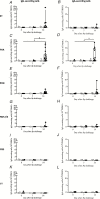Controlled Human Infection With Bordetella pertussis Induces Asymptomatic, Immunizing Colonization
- PMID: 31562530
- PMCID: PMC7353841
- DOI: 10.1093/cid/ciz840
Controlled Human Infection With Bordetella pertussis Induces Asymptomatic, Immunizing Colonization
Abstract
Background: Bordetella pertussis is among the leading causes of vaccine-preventable deaths and morbidity globally. Human asymptomatic carriage as a reservoir for community transmission of infections might be a target of future vaccine strategies, but has not been demonstrated. Our objective was to demonstrate that asymptomatic nasopharyngeal carriage of Bordetella pertussis is inducible in humans and to define the microbiological and immunological features of presymptomatic infection.
Methods: Healthy subjects aged 18-45 years with an antipertussis toxin immunoglobin G (IgG) concentration of <20 international units/ml were inoculated intranasally with nonattenuated, wild-type Bordetella pertussis strain B1917. Safety, colonization, and shedding were monitored over 17 days in an inpatient facility. Colonization was assessed by culture and quantitative polymerase chain reaction. Azithromycin was administered from Day 14. The inoculum dose was escalated, aiming to colonize at least 70% of participants. Immunological responses were measured.
Results: There were 34 participants challenged, in groups of 4 or 5. The dose was gradually escalated from 103 colony-forming units (0% colonized) to 105 colony-forming units (80% colonized). Minor symptoms were reported in a minority of participants. Azithromycin eradicated colonization in 48 hours in 88% of colonized individuals. Antipertussis toxin IgG seroconversion occurred in 9 out of 19 colonized participants and in none of the participants who were not colonized. Nasal wash was a more sensitive method to detect colonization than pernasal swabs. No shedding of Bordetella pertussis was detected in systematically collected environmental samples.
Conclusions: Bordetella pertussis colonization can be deliberately induced and leads to a systemic immune response without causing pertussis symptoms.
Clinical trials registration: NCT03751514.
Keywords: Bordetella pertussis; carriage; human challenge; mmune response.
© The Author(s) 2019. Published by Oxford University Press for the Infectious Diseases Society of America.
Figures



 inoculum dose 103 cfu (n = 5),
inoculum dose 103 cfu (n = 5),  inoculum dose 104 cfu (n = 9),
inoculum dose 104 cfu (n = 9),  inoculum dose 5x104 cfu (n = 5),
inoculum dose 5x104 cfu (n = 5),  inoculum dose 105 cfu (n = 15). Day 0 was the day of inoculation. Results are presented as scatter plots with median values. *Significance between time points (P < .05), using the Wilcoxon test. Abbreviations: AU, arbitrary units; Bp, Bordetella pertussis; cfu, colony-forming units; FHA, filamentous hemaglutinin; FIM 2/3, fimbriae 2/3; IgG, immunoglobin G; IU, international units; PRN, pertactin; PT, pertussis toxin.
inoculum dose 105 cfu (n = 15). Day 0 was the day of inoculation. Results are presented as scatter plots with median values. *Significance between time points (P < .05), using the Wilcoxon test. Abbreviations: AU, arbitrary units; Bp, Bordetella pertussis; cfu, colony-forming units; FHA, filamentous hemaglutinin; FIM 2/3, fimbriae 2/3; IgG, immunoglobin G; IU, international units; PRN, pertactin; PT, pertussis toxin.

Comment in
-
Toward a Controlled Human Infection Model of Pertussis.Clin Infect Dis. 2020 Jul 11;71(2):412-414. doi: 10.1093/cid/ciz842. Clin Infect Dis. 2020. PMID: 31552410 Free PMC article. No abstract available.
References
-
- Yeung KHT, Duclos P, Nelson EAS, Hutubessy RCW. An update of the global burden of pertussis in children younger than 5 years: a modelling study. Lancet Infect Dis 2017; 17:974–80. - PubMed

